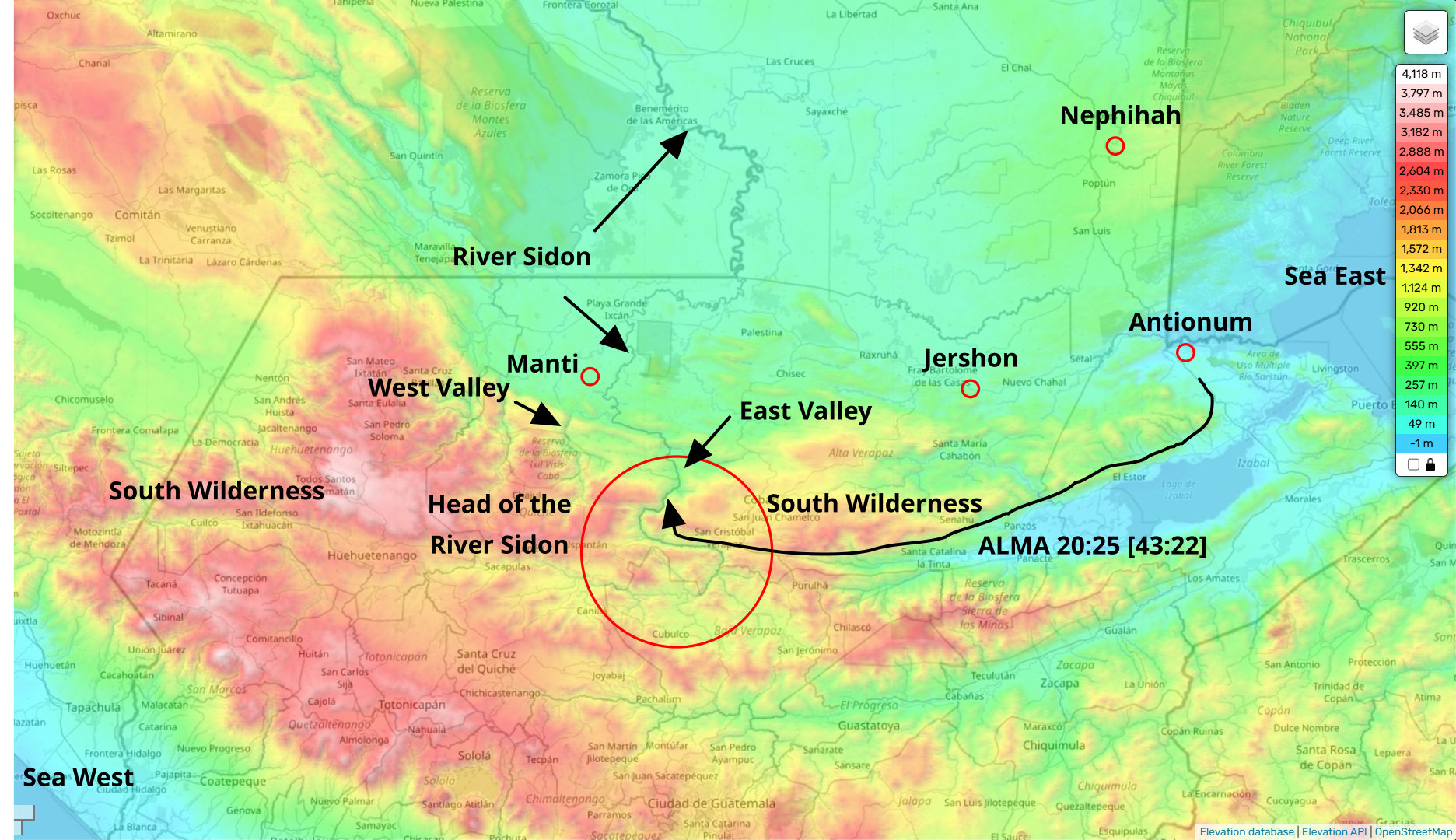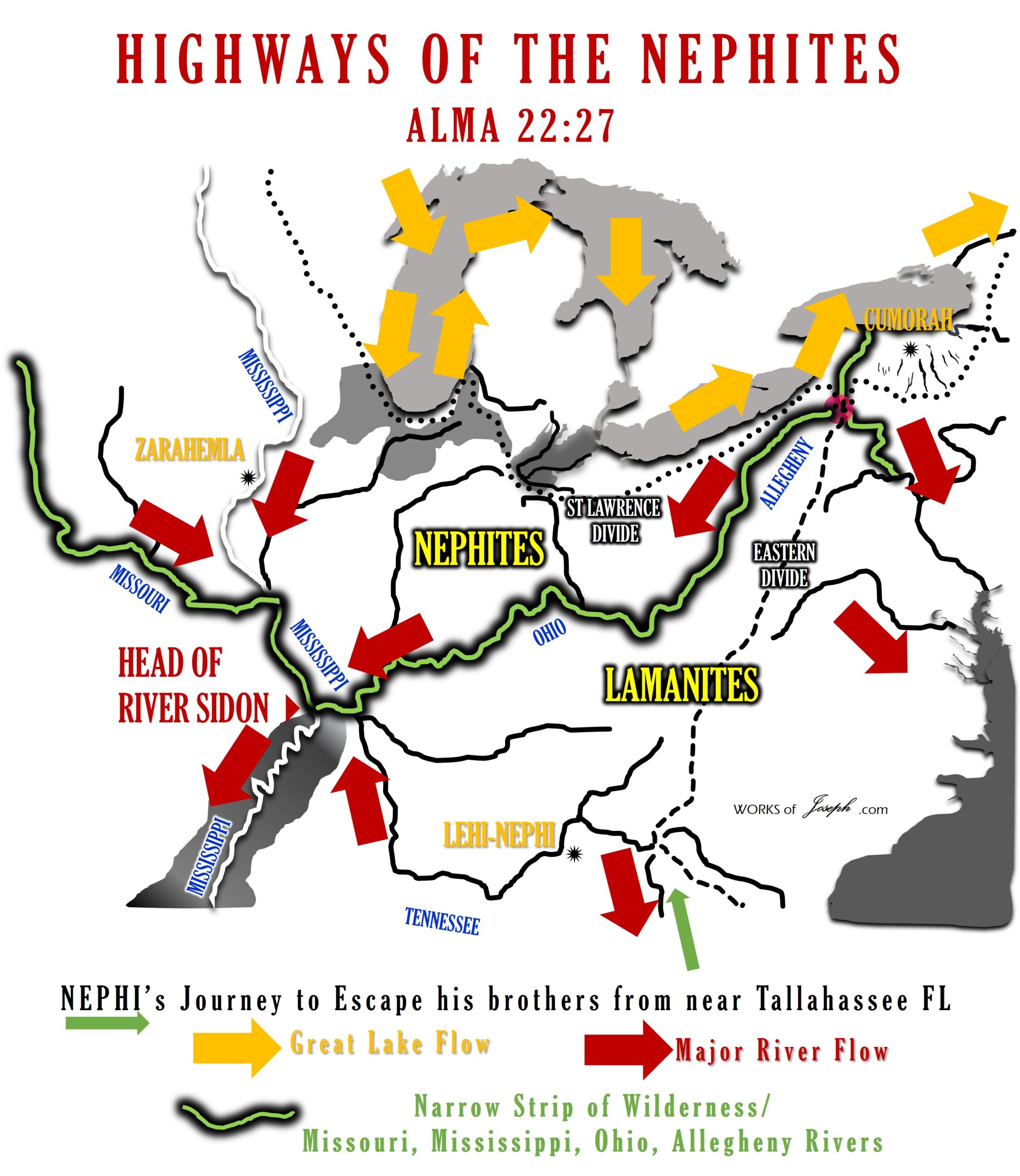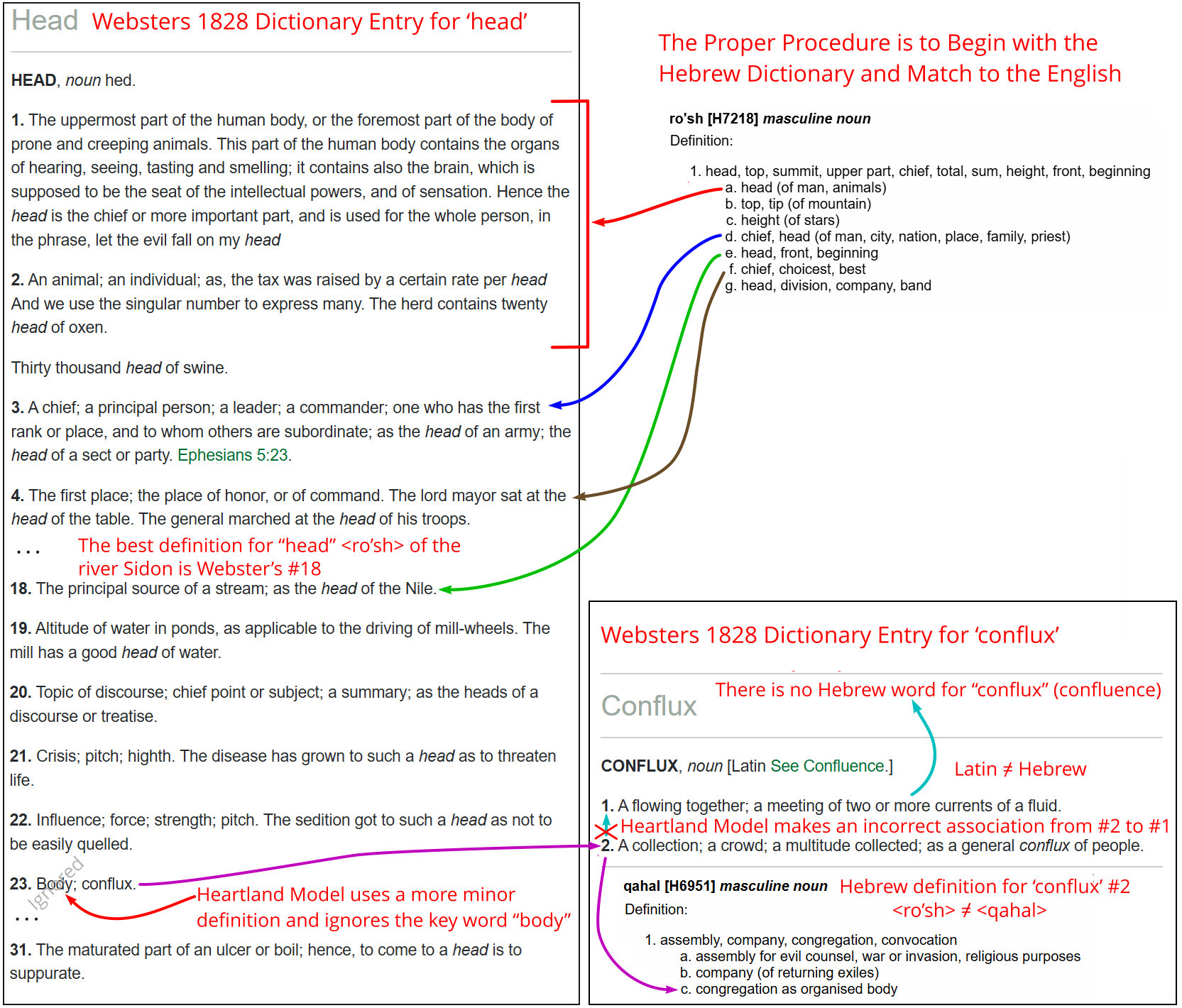The head (headwaters) of the river Sidon is described to be in the south wilderness.
ALMA 20:25 [43:22] Behold, now it came to pass, that they durst not come against the Nephites in the borders of Jershon; therefore they departed out of the land of Antionum, into the wilderness, and took their journey round about in the wilderness, away by the head <ro'sh> [Strong's H7218] of the river Sidon, that they might come into the land of Manti, and take possession of the land; for they did not suppose that the armies of Moroni would know whither they had gone.
- Commentary: The wilderness here is the south wilderness. Antionum is close to the sea East. The head of the river Sidon is located in the south wilderness.
ALMA 26:28 [56:25]: Neither durst they march down against the city of Zarahemla; neither durst they cross the head of Sidon, over to the city of Nephihah.
- Commentary: This verse references the places of Antiparah, Cumeni, Judea, Nephihah, a ridge between the headwaters of the river Sidon and the city of Nephihah, river Sidon, river Sidon (headwaters), and Zarahemla. Helaman is making this statement and he is in Judea at this time. The Lamanites are currently in control of the cities of Antiparah, Cumeni, and Zeezrom. This verse is talking about some of the options the Lamanites do not have. The phrase 'march down' means that the cities of Antiparah, Cumeni, and Zeezrom are higher in elevation than the land of Zarahemla. Since the Lamanites are in control of these cities, this verse describes a general line from the lands of Antiparah, Cumeni, and Zeezrom to the land of Nephihah by way of the headwaters of the river Sidon. The word 'cross' indicates crossing over water, which indicates that water flow exists at the head of the river Sidon (that they cannot go around) and may be downstream from the actual headwaters of the river.
Isthmus of Tehuantepec (Mexico) Model Assessment:
The head of the river Sidon fits the geography of the Usumacinta river in Guatemala.
- The Usumacinta River is the river Sidon
- The Head of the Usumacinta River is in the wilderness to the south and this south wilderness is relatively narrow and extends from east to the west
- Where the Usumacinta River enters the south wilderness, there are a west and east valleys and the east valley is the route through the wilderness
Head of the River Sidon (Isthmus of Tehuantepec)

(Tap to Expand)
Heartland Model Assessment:
The Heartland Model claims that the confluence of the Mississippi River and Ohio river is the head of the River Sidon.
Head of the River Sidon (Heartland Model)

(Tap Image to Expand - Source Here)
In Noah Webster's 1828 dictionary, the reference dictionary in Joseph Smiths time, the word 'head' as relating to a river is defined thus.
'Head, 18. The principal source of a stream; as the head of the Nile.'
Websters 1828 Dictionary (definition: head)
Websters 1828 Dictionary (definition: head)
While this is one definition, there is also another equally valid definition relating to rivers which is less well known but very important to a more complete understanding.
Description 23. states 'Conflux'. [note: this example shows a Fallacy of Exclusion where the true definition option of 'body' is hidden]
To be sure exactly what 'Conflux' means, this same dictionary defines it as;
CONFLUX, n. [L. See Confluence.] Websters 1828 Dictionary (definition: conflux)
CONFLUX, n. [L. See Confluence.] Websters 1828 Dictionary (definition: conflux)
1. A flowing together; a meeting of two or more currents of a fluid.
Again in this same dictionary the word 'confluence' is defined as follows:
CONFLUENCE, n. [L., to flow. See Flow.] Websters 1828 Dictionary (definition: confluence)
1. A flowing together; the meeting or junction of two or more streams of water, or other fluid; also, the place of meeting; as the confluence of the Tigris and the Frat, or of the Ohio and Mississippi.
CONFLUENCE, n. [L., to flow. See Flow.] Websters 1828 Dictionary (definition: confluence)
1. A flowing together; the meeting or junction of two or more streams of water, or other fluid; also, the place of meeting; as the confluence of the Tigris and the Frat, or of the Ohio and Mississippi.
Assessment of the Heartland Model interpretation of 'head'
The procedure to select the above definition of 'conflux' and 'confluence' is an example of a Fallacy of Exclusion (excluding evidence that could change the outcome of an argument) since the correct definition for 'conflux' is not presented. The Heartland Model uses a definition of a Latin-based homonym (head = conflux) rather than the Hebrew definition (head = ro'sh) - which is the primary English translation of the original Hebrew basis for the Book of Mormon. There is no Old Testament Hebrew word for 'confluence' from which to translate into a word that means 'confluence.' There is also no description of a 'confluence' in the Old Testament. Old Testament Hebrew seems to have no concept for 'confluence.' The etymology of 'confluence' is it originated in the 15th century from the Latin confluentem.
The Heartland Model procedure to define 'head' = 'confluence' is an incorrect procedure involving two logical fallacies (1) Fallacy of Exclusion to ignore 'body' as the key word in the definition for 'head' entry #23 and (2) another Fallacy of Exclusion to present 'conflux' entry #1 as the 'correct' - but actually incorrect - definition and ignore 'conflux' entry #2 which is the correct association for 'head' entry #23). The image below shows both the incorrect process used by the Heartland Model and the more correct procedure to determine the meaning of 'head' from the original Hebrew.
Proper and Improper Procedure to define 'head'

(Tap to Expand)
More of the Heartland Model reasoning regarding a 'confluence' is located here.
The Heartland Model interpretation of Genesis 2:10 is as follows (Source):
- Genesis 2:10 says, 'A river watering the garden flowed from Eden; from there it was separated into four headwaters.' This is interpreted as meaning that four rivers joined into one and then that one river flowed through the Garden and emptied into the Gulf.
Assessment of the Heartland Reasoning concerning Genesis 2:10
Genesis 2:10 And a river went out of Eden to water the garden; and from thence <sham> it was parted <parad>, and became into four heads <ro'sh>.
- Hebrew <parad> H6504 - Usage in the Old Testament: separate (12x), part (4x), divided (3x), scattered abroad (1x), dispersed (1x), joint/out of joint (1x), scattered (1x), severed (1x), stretched (1x), sundered (1x).
- In Hebrew, <parad> is never used to indicate any kind of joining
- 'from thence' <sham> H8033 - 'out of' indicates the river was parted from (out of) a single flow not combined into a single flow
- The four rivers of Eden were separated from one - they were not a confluence
- The heads <ro'sh> were four separate beginnings of four rivers
- Similar examples:
- [Exo 12:2] This month shall be unto you the beginning <ro'sh> of months
- [Psa 119:160] Thy word is true from the beginning <ro'sh>:
- [Prov 8:23] I was set up from everlasting, from the beginning <ro'sh>
- [Lam 2:19] Arise, cry out in the night: in the beginning <ro'sh> of the watches
